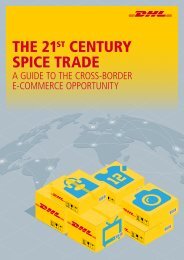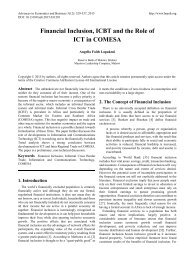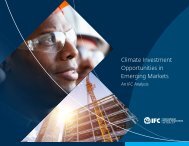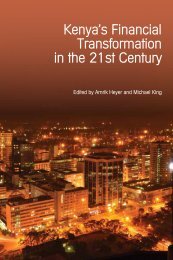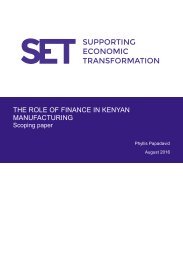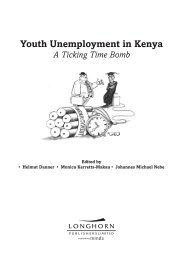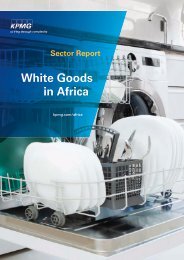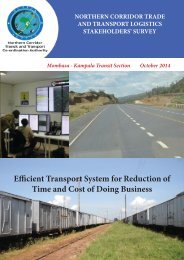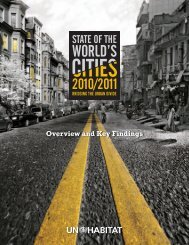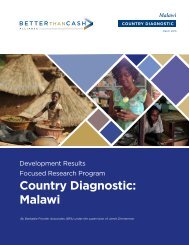FD
gvti301SEaf
gvti301SEaf
You also want an ePaper? Increase the reach of your titles
YUMPU automatically turns print PDFs into web optimized ePapers that Google loves.
AFRICA<br />
broaden the tax base. The average tax-to-GDP ratio increased<br />
from 18 percent in 2000–02 to 21 percent in 2011–13—<br />
equivalent to half the development aid Africa received in<br />
2013 (Africa Progress Panel, 2014). The increase in domestic<br />
financing is no doubt the result of debt relief, some increased<br />
tax revenue collection, gains from the commodity price boom,<br />
and improved macroeconomic and institutional policies.<br />
But it will be hard for many countries to find more domestic<br />
revenue. Tax mobilization remains low despite significant<br />
effort and recent reforms in non-resource-rich countries<br />
(Bhushan, Samy, and Medu, 2013). The ratio of general government<br />
tax revenue to GDP in 2013 ranged from 2.8 percent in<br />
the Democratic Republic of the Congo to 25 percent in South<br />
Africa (one of the highest among developing economies).<br />
Helping African countries raise more funds domestically for<br />
many purposes, including infrastructure, should be a priority<br />
for African policymakers and the international community. In<br />
2015, global donors committed to helping African countries<br />
Reducing inefficiencies could<br />
substantially increase the<br />
economic dividends from<br />
public investment.<br />
improve tax collection. In 2011, the latest year for which figures<br />
are available, less than 1 percent of official development<br />
assistance went to domestic revenue mobilization.<br />
Second, sources of domestic revenue should be broadened.<br />
From 2006 to 2014, 13 countries issued a total of $15 billion<br />
in international sovereign bonds, often intending to use<br />
the proceeds to finance infrastructure. But a more prudent<br />
and sustainable way to finance infrastructure would be to<br />
increase the participation of domestic institutional investors,<br />
such as pension funds.<br />
African pension funds have about $380 billion in assets<br />
under management, 85 percent of which are in South Africa<br />
(see table). In countries such as Cabo Verde, Kenya, South<br />
Africa, Swaziland, Tanzania, and Uganda, funds are investing<br />
in infrastructure (Inderst and Stewart, 2014). Pension fund<br />
trustees and managers should consider whether risk-adjusted<br />
investments can be made within the context of their fiduciary<br />
duty to beneficiaries. Countries must also improve the governance,<br />
regulation, and development of domestic financial<br />
and capital market instruments for infrastructure investment—and<br />
seek to attract foreign institutional investors too.<br />
Third, funds must be spent efficiently. Most of the debate on<br />
infrastructure needs in sub-Saharan Africa focuses on financing<br />
issues. But there is evidence that efficiency, not financing,<br />
is often the barrier to investment. For example, the IMF (2015)<br />
estimates that about 40 percent of the potential value of public<br />
investment in low-income countries is lost to inefficiencies<br />
in the investment process due to time delays, cost overruns,<br />
and inadequate maintenance. Those inefficiencies are often<br />
Mine the gap<br />
Pension fund assets in Africa could be tapped as a source for<br />
investment in infrastructure.<br />
Pension Fund Assets under Management<br />
Country<br />
(billions of U.S. dollars)<br />
South Africa 322.0<br />
Nigeria 25.0<br />
Namibia 10.0<br />
Kenya 7.3<br />
Botswana 6.0<br />
Tanzania 3.1<br />
Ghana 2.6<br />
Zambia 1.8<br />
Uganda 1.5<br />
Rwanda 0.5<br />
Total 379.8<br />
Sources: Making Finance Work for Africa; and author’s calculations.<br />
Note: Asset amounts represent the latest figures available.<br />
the result of undertrained officials; inadequate processes for<br />
assessing needs and preparing for and evaluating bids; and corruption.<br />
Reducing inefficiencies could substantially increase<br />
the economic dividends from public investment.<br />
The 2009 World Bank study estimated that if inefficiencies<br />
were addressed through such measures as rehabilitating<br />
existing infrastructure, targeting subsidies better, and<br />
improving budget execution—in other words more efficient<br />
use of existing infrastructure—the $93 billion financing need<br />
could be reduced by $17 billion. That means that the focus<br />
of attention on infrastructure should be broadened beyond<br />
financing issues to include efforts to improve efficiency. This<br />
is a complex task that requires African governments and the<br />
international community to focus on individual sectors and<br />
how they operate in particular countries and requires robust<br />
monitoring capability.<br />
Amadou Sy is a senior fellow and director of the Africa Growth<br />
Initiative at the Brookings Institution.<br />
References:<br />
Africa Progress Panel, 2014, “Grain Fish Money: Financing Africa’s<br />
Green and Blue Revolutions,” Africa Progress Report 2014” (Geneva).<br />
Bhushan, Aniket, Yiagadeesen Samy, and Kemi Medu, 2013,<br />
“Financing the Post–2015 Development Agenda: Domestic Revenue<br />
Mobilization in Africa,” North-South Institute Research Report (Ottawa).<br />
Foster, Vivien, and Cecilia Briceño-Garmendia, 2009, “Africa’s<br />
Infrastructure: A Time for Transformation,” Africa Development Forum<br />
Series (Washington: World Bank).<br />
Gutman Jeffrey, Amadou Sy, and Soumya Chattopadhyay, 2015,<br />
Financing African Infrastructure: Can the World Deliver? (Washington:<br />
Brookings Institution).<br />
Inderst, Georg, and Fiona Stewart, 2014, Institutional Investment<br />
in Infrastructure in Emerging Markets and Developing Economies<br />
(Washington: World Bank).<br />
International Monetary Fund (IMF), 2014, Regional Economic<br />
Outlook: Sub-Saharan Africa—Staying the Course (Washington, October).<br />
———, 2015, “Making Public Investment More Efficient,” IMF Staff<br />
Report (Washington).<br />
Finance & Development June 2016 27



